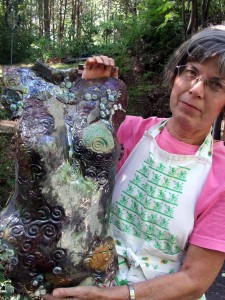
Below is an excerpt from one of my Sell Your Art, Keep Your Soul coaching modules. Since you are paying attention and have arrived here to read, you get this usually charged for item free. Pat yourself on the back and go play lotto – it must be your lucky day!
Here’s a way to start figuring your pricing: how much you want to make an hour; how long it takes to make your work.
Example 1: If you want to make $50/hour, and you charge $2.50 for a product wholesale (i.e. what a shop will pay you for it), then you need to be able to make 20 pieces of that product in an hour. It does not count that you can sell the product for $5 each directly at shows. The price must be figured on the lowest amount you will be charging.
Important: You cannot undersell your galleries. This is an unbreakable rule.
Example 2: If you want to make $50/hour, and you charge $12 for a product wholesale, then you need to be able to make 4 pieces an hour.
NOTE: Neither of the above examples takes into consideration time for tagging, packaging and delivering, etc. Obviously if you hire someone and pay them $8/hour to do that for you, you are saving money. Think about it!
While this method ties you to an hourly income, it is as good a place as any to start. Eventually, however, you will want to roll in accounting for the years you have spent learning how to make your art, the time and thought you give your art when you aren’t actually working on it, the beauty it brings into the world, and the fact that you are the only one who can make this particular art.
Here is a story
(Maybe true, maybe urban myth – it doesn’t matter)
An associate dining with Pablo Picasso took a napkin and asked for a sketch. Picasso dashed off a simple line drawing. When finished, he handed the napkin to his associate and said, “That will be one million dollars.” “One million dollars!” exclaimed the associate. “That only took you a minute to draw!” Picasso’s response: “But it took me 50 years to learn how to draw that in one minute.”
Become one with Picasso. Value your work.
Example 3. You sell both to shops and to individuals at fairs and festivals.
Important enough to repeat: do not undersell your shops. This will immediately get you a very bad reputation.
If you wholesale at $3.00 and your shops sell that product at $6.00 then you must sell that product for $6.00 retail wherever you sell. Some shops expect a 35 – 60% cut whether they buy wholesale or offer consignment. You are free to deal with whomever at whatever rates you wish to negotiate. If it is a very prestigious shop, you may be willing to drop your profit in order to establish your art in a certain area. That is a business decision.
For my own work, I do a 40-60% split (shop 40%) for consignment (where you get paid when the product sells, and which requires meticulous record keeping by both parties), and 50-50% for wholesale (i.e. where you get paid up front for your wares). I have noticed lately that the amount shops want is beginning to start at 50-50% for everything. Which means shortly I will have to increase my prices across the board if I wish to maintain my income.
Example 4. Price by size: the bigger the piece, the higher the value. It doesn’t matter if the bigger piece is easier to make. We live in a culture that believes that if you buy a bigger piece you are getting a better deal.
Example 5. Price by how much you like it. My favorite pieces are always my highest priced pieces because I don’t care if they sell. After several times out, they wind up in my home. This makes my daughter very happy as she is convinced that when I die they will pay for her lavish retirement lifestyle.
Here’s a Secret
In my early years of festival sitting I had a lot of time to play with pricing. I used all of the above, even changing prices over the course of the festival to see if it made a difference (it didn’t). In fact, I even marked pieces “free if you ask me.”
The secret: if someone falls in love with your art, they don’t care about price. Price is not what makes people stop and look, and their heart go pitty-pat. It is the energy – your energy – in the piece. If the piece can’t make them stop and their heart go pitty-pat, it doesn’t matter what your price is. So price your work to reach your income goal. And define your people/demographic so you’ll know where to find the folks whose hearts will go pitty-PITTY pat-PAT the moment they see your work.
Here’s Another Story
I was visiting a shop that had once carried my higher end ceramic work. I wanted the owner to look at my jewelry line. Well, she did. And she didn’t purchase any of it. I had a range from about $45 to about $125 retail. What she did do later in the week was call and ask to purchase the beadwork necklace I had been wearing, for $225.00 ($450 retail). A decision she made after I had left for home!
And a bonus story (from my coach): She and her husband decided to give their bathroom a good scrub. So off he went to the store. When he got there, he found there were many different scrubs and he didn’t have a clue which was best. So he bought the most expensive one because he figured: more expensive, better product! As it turns out, it wasn’t a better product and off he went again. But pay attention to that reasoning!
And yet another story (because stories capture the magic and whimsy of everyday life). I sold several items to a shop. They would not reorder. Five years later, the same manager saw me as featured artist at an on-line venue. She ordered 20 pieces and was beside herself that she was so lucky to find me. Then an acquaintance, seeing the pictures shown around by the excited shop manager, ordered three – of the same pieces I had out at a show she came to not quit a month previously.
You cannot make this stuff up! Go. Start collecting your own stories.
Handling Commission
Many of my clients get all balled up over commissions. They want to sell their art. They want to please their client. And in the process they forget they need to pay themselves!
Here’s a good way to handle commissions – and feel free to modify any or all of the pieces (remember: no right or wrong way). This is just a jumping off space.
A client decides she wants to commission you and wants your price right then and there. Say no. Tell her you cannot give her a price until you are both clear on the work. Set up a meeting date for NO MORE than ½ hour hour. You can charge whatever your going rate is for this: if she won’t pay you for ½ hour’s work, do you think it’s going to be easy getting her to pay you fairly for your finished piece?
Make sure she brings what you need to this meeting: sketches, color swatches, etc. Tell her without those you cannot successfully meet and plan.
Meet. Do NOT give her the price. Make sure you understand what she wants. Thank her for her time and tell her you will get back to her (tomorrow, 2 days) with the price and your contract. You have now established yourself as the leader. And you have bought yourself time to think through how much time and trouble this is going to be so you can price accordingly.
In your “contract” – which doesn’t have to be any more than a listing of what you agreed to – outline what you’ve agreed to, set a date for meeting and approval of a preliminary sketch at which point you get 1/3 of your agreed upon price. That price includes one and only one modification. Any more are charged at (whatever your rate is). Make it clear the initial payment is non-refundable as it covers your cost, materials and time.
Meet half-way through for final approval. At that point you collect another (non-refundable) 1/3 payment. If she has not used her one modification, she can use it now. If she has, then she understands that another modification will cost her a fee.
Collect the final payment upon delivery.
You are an artist. She is not doing you a favor by buying your art and you should feel to need to bend your rules. If she is willing to follow your rules, she will be a good client. My favorite commissions are the ones where my client says: “You’re the artist, you do what you think is best.” I love these! And yes, there are more of them out there than you can imagine!
Of course there is much more to the whole module, but this is a good place to start and should be enough to spark some brainstorm type thoughts on your own part. I’d love to hear your own thoughts on pricing art as there *really* isn’t a right and wrong way and I have no corner on understanding the market!
I also have a great module on finding venues and the questions you should ask before you “sign on the dotted line.” Perhaps I will put that up later this month if I get enough comments that this excerpt was helpful!



4 Comments
Thanks Tammy for this informative article! Much appreciated.
Hi Paula – glad you found it helpful.
I’m a great believer in just name your price. If they
really want it, they’ll buy it!
Carissa – thanks for that reminder. In fact, some shops are the same way.
You make some good points and suggestions, Tammy. If I may add, most galleries have exclusive expectations. So I always clarify those perameters. For example, I will promise not to sell in another gallery in their town or no other gallery within a 25 mile radius. If I have an exhibit or show near them, I will request an exception. Usually, mentioning them in the press release and/or the artist statement makes it all good.
It´s very useful to get this type of advice from someone who can say “been there, done that”. 😀 Naming your price for a mass made product is easier from the analytical point of view: materials+labour+gain+tax. Handmade adds a dimension of talent & expertise that is more difficult to define.